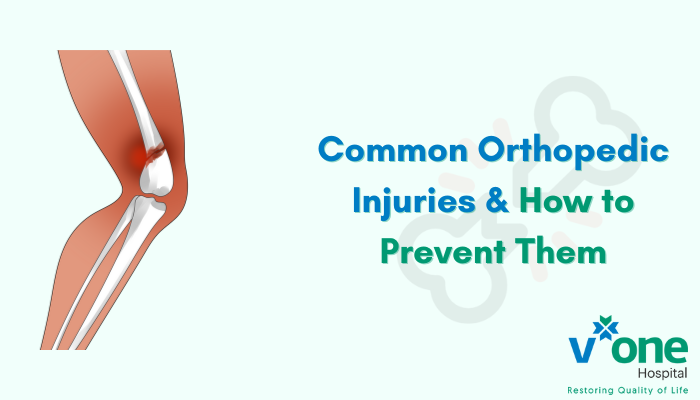10 Common Orthopedic Injuries and How to Prevent Them
Orthopedic injuries are a widespread concern, affecting people of all ages and lifestyles. These injuries involve damage to the musculoskeletal system, which includes bones, muscles, ligaments, tendons, and joints. While some injuries are sudden and traumatic, others develop gradually due to overuse or poor biomechanics. Regardless of the cause, orthopedic injuries can lead to pain, reduced mobility, and a significant impact on daily activities. In this comprehensive blog, we will delve into the ten most common orthopedic injuries and provide detailed insights on how to prevent them. Remember, seeking guidance from an experienced orthopaedic doctor in Indore or consulting the best orthopedic surgeon in Indore can be crucial for personalized care and effective treatment.
10 Most Common Orthopedic Injuries
Sprains and Strains
Sprains and strains are among the most common orthopedic injuries, affecting ligaments and muscles, respectively. These injuries typically occur due to sudden movements, improper techniques during physical activities, or accidents. Preventing sprains and strains involves a combination of proper warm-up routines, correct exercise techniques, and wearing appropriate protective gear. Before engaging in any physical activity, take a few minutes to warm up your muscles with light exercises or stretches. This helps increase blood flow to the muscles and prepares them for more intense movements. Also, ensure that you use the correct form and technique while performing exercises or playing sports. Lastly, don’t forget to wear protective gear like knee pads, wrist guards, or ankle braces to reduce the risk of injury.
Fractures
Fractures, or broken bones, can occur as a result of falls, accidents, or high-impact trauma. To prevent fractures, it’s essential to be cautious and avoid risky behaviors. When participating in sports or outdoor activities, follow safety guidelines and use appropriate protective equipment, such as helmets, elbow pads, or shin guards. Consuming a well-balanced diet rich in calcium and vitamin D is also crucial for maintaining strong bones, reducing the risk of fractures.
Tendonitis
Tendonitis is the inflammation of tendons, which are thick cords that attach muscles to bones. Overuse or repetitive movements can lead to tendonitis, causing pain and discomfort. To prevent this condition, it’s vital to allow your body enough time to rest and recover between intense workouts or physical activities. Incorporate low-impact exercises, such as swimming or cycling, into your routine to reduce strain on the tendons. When engaging in repetitive movements, take regular breaks and stretch to maintain flexibility and reduce the risk of overuse injuries.
Dislocations
Dislocations occur when the bones forming a joint are forced out of their usual positions. These injuries can be painful and may require immediate medical attention. Strengthening the muscles around the joints through targeted exercises can help stabilize the joint and reduce the risk of dislocation. Additionally, it’s essential to avoid putting excessive pressure on the joints, especially during activities that involve sudden and forceful movements. If you have a history of joint dislocations or instability, consult an orthopaedic doctor in Indore for personalized advice on injury prevention.
Rotator Cuff Injuries
The rotator cuff is a group of muscles and tendons in the shoulder, responsible for its stability and mobility. Rotator cuff injuries often occur due to repetitive overhead movements or sudden impacts. To prevent these injuries, practice proper posture and body mechanics during activities that involve the arms, such as lifting or reaching. When engaging in sports like swimming, tennis, or baseball, ensure that you warm up and stretch your shoulder muscles before starting the activity. Using ergonomic equipment and modifying your technique can also help reduce strain on the rotator cuff.
Tennis/Golfer’s Elbow
Tennis elbow (lateral epicondylitis) and golfer’s elbow (medial epicondylitis) are conditions that cause pain around the elbow joint. These injuries are common in individuals who engage in repetitive gripping or wrist movements, such as tennis players, golfers, or those involved in manual labor. To prevent tennis or golfer’s elbow, practice proper techniques and grips in sports and activities that involve repetitive wrist movements. Strengthening the forearm muscles and using proper equipment, such as racquets with shock-absorbing features, can also reduce the strain on the elbows.
Knee Injuries
Knee injuries, such as ACL (anterior cruciate ligament) tears or meniscus injuries, are prevalent among athletes and active individuals. These injuries often occur due to sudden twisting or pivoting movements, high-impact landings, or direct blows to the knee. Preventing knee injuries involves a combination of strengthening exercises and proper body mechanics. Strengthening the muscles around the knee, including the quadriceps and hamstrings, can provide added support and stability to the joint. Wearing supportive footwear with proper cushioning can reduce the impact on the knees during physical activities. Additionally, avoid sudden and forceful twisting movements, especially when landing from jumps or changing directions quickly.
Back Pain
Back pain is a common orthopedic complaint and can result from various factors, such as poor posture, improper lifting techniques, or weak core muscles. To prevent back pain, it’s essential to practice good posture throughout the day, whether sitting, standing, or walking. Engaging in regular back-strengthening exercises, such as yoga or pilates, can improve core strength and stability, reducing the strain on the back. When lifting heavy objects, remember to use proper body mechanics by bending your knees and keeping your back straight. Avoid twisting while lifting and use your leg muscles to power the lift instead of straining your back.
Shin Splints
Shin splints are characterized by pain along the shinbone (tibia) and commonly affect runners and athletes involved in high-impact activities. To prevent shin splints, it’s essential to wear appropriate footwear that provides adequate support and cushioning. Gradually increase the intensity of your exercise routine, giving your body time to adapt and strengthen the muscles gradually. Adding shock-absorbing insoles to your shoes can also help reduce the impact on the shins during running or jumping activities.
Stress Fractures
Stress fractures are tiny cracks in bones that occur due to repetitive activities and overuse. They are commonly seen in runners, dancers, and military personnel. Preventing stress fractures involves a combination of maintaining a well-balanced diet and varying your exercise routine. Ensure that you consume sufficient amounts of calcium and vitamin D, as these nutrients are essential for bone health. Avoid excessive training without adequate rest and recovery periods. Incorporating low-impact activities, such as swimming or cycling, can provide your bones and joints with a break from repetitive impact and reduce the risk of stress fractures.
Conclusion
Orthopedic injuries can significantly impact your quality of life, making prevention a crucial aspect of maintaining musculoskeletal health. By following these preventive measures and incorporating them into your daily life, you can reduce the risk of common orthopedic injuries and enjoy an active and pain-free lifestyle. Remember that every person’s body is unique, and seeking guidance from an orthopaedic doctor in Indore or consulting with the best orthopedic surgeon in Indore can provide personalized advice and support tailored to your specific needs. Prioritize your musculoskeletal health, and embrace the joy of movement for a happier and healthier you.

